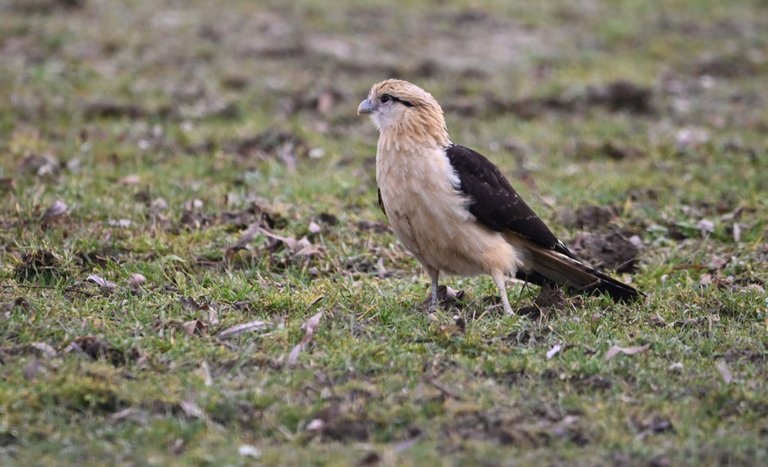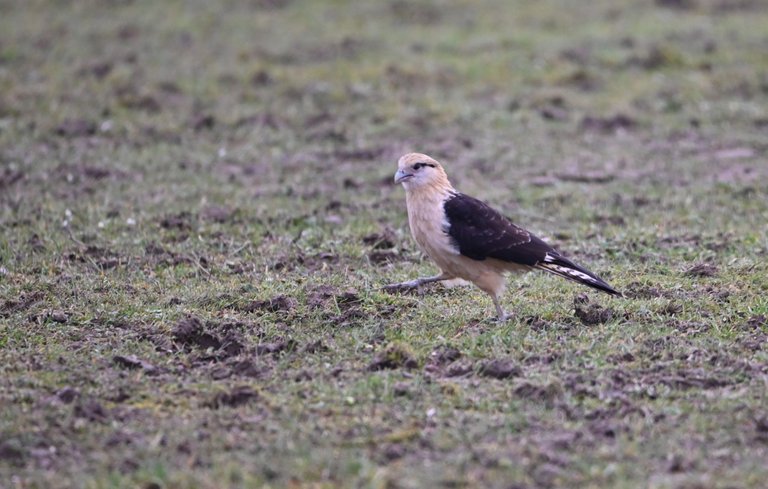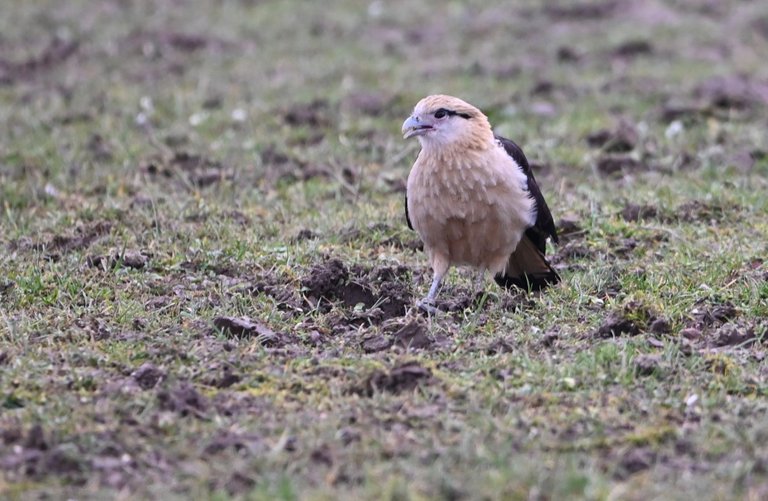Yellow-headed caracara probably fled from captivity
Today I had the luck to find a bird that usually doesn't exist in europe but in south america. The Yellow-headed caracara wich is nearly for sure a bird that fled from captivity has been seen by a ornithological friend of mine today and he told me the region where he saw it, so I decided to visit the spot just to check if it was still there and luckily it was and I even could take some pictures of it. So i have expanded my list of seen birds and also the list with the bird that I photographed with one aditional species, this yellow-headed caracara.
I was pretty lucky that I found this bird and photographed from the car, I assume this way I was able to get that close without the bird fleeing. It was sitting on a field near the street and I could take some pictures out of the car. I am pretty sure that if I approached it without the car it wouldn't have been so easy to get that close.
It is a bird that probably fled from captivity since this bird usually don't lives in Europe and I don't think it migrated here.
Yellow-headed caracara on a field in Austria. Picture: Florian Glechner.
| Camera used | Nikon Z6II |
|---|---|
| Lens used | Sigma 150-600 mm lens + FTZ |
| Filter used | none |
| Exposure Time | 1/2000 Seconds |
| Aperture used | F6.3 |
| Focal Length | 600 mm |
| Time | 02:49 pm |
| ISO | 100 |
Since I am recording the bird species that I have seen on my trips I saw 174 different species here in Austria. This is already a lot but I know people that have already seen 300 or more different species and getting one mor species on the list without leaving the country is pretty difficult. I am sure I can increase the number of different bird species seen dramatically if i travel to south america or to africa or australia since there still live so many different species that never come to our part of the world. All the resident birds are more or less easier to find, the migratory birds are a bit of a challenge and the most difficult ones are the ones that can only be found when travelling to different locations, like north or south america or australia, asia.
Picture: Florian Glechner.
| Camera used | Nikon Z6II |
|---|---|
| Lens used | Sigma 150-600 mm lens + FTZ |
| Filter used | none |
| Exposure Time | 1/2000 Seconds |
| Aperture used | F6.3 |
| Focal Length | 600 mm |
| Time | 02:49 pm |
| ISO | 100 |
Picture: Florian Glechner.
| Camera used | Nikon Z6II |
|---|---|
| Lens used | Sigma 150-600 mm lens + FTZ |
| Filter used | none |
| Exposure Time | 1/2000 Seconds |
| Aperture used | F6.3 |
| Focal Length | 600 mm |
| Time | 02:49 pm |
| ISO | 100 |
Picture: Florian Glechner.
| Camera used | Nikon Z6II |
|---|---|
| Lens used | Sigma 150-600 mm lens + FTZ |
| Filter used | none |
| Exposure Time | 1/2000 Seconds |
| Aperture used | F6.3 |
| Focal Length | 600 mm |
| Time | 02:49 pm |
| ISO | 100 |
Picture: Florian Glechner.
| Camera used | Nikon Z6II |
|---|---|
| Lens used | Sigma 150-600 mm lens + FTZ |
| Filter used | none |
| Exposure Time | 1/2000 Seconds |
| Aperture used | F6.3 |
| Focal Length | 600 mm |
| Time | 02:49 pm |
| ISO | 100 |
Picture: Florian Glechner.
| Camera used | Nikon Z6II |
|---|---|
| Lens used | Sigma 150-600 mm lens + FTZ |
| Filter used | none |
| Exposure Time | 1/2000 Seconds |
| Aperture used | F6.3 |
| Focal Length | 600 mm |
| Time | 02:49 pm |
| ISO | 100 |
Picture: Florian Glechner.
| Camera used | Nikon Z6II |
|---|---|
| Lens used | Sigma 150-600 mm lens + FTZ |
| Filter used | none |
| Exposure Time | 1/2000 Seconds |
| Aperture used | F6.3 |
| Focal Length | 600 mm |
| Time | 02:49 pm |
| ISO | 100 |
Picture: Florian Glechner.
| Camera used | Nikon Z6II |
|---|---|
| Lens used | Sigma 150-600 mm lens + FTZ |
| Filter used | none |
| Exposure Time | 1/2000 Seconds |
| Aperture used | F6.3 |
| Focal Length | 600 mm |
| Time | 02:49 pm |
| ISO | 100 |
Picture: Florian Glechner.
| Camera used | Nikon Z6II |
|---|---|
| Lens used | Sigma 150-600 mm lens + FTZ |
| Filter used | none |
| Exposure Time | 1/2000 Seconds |
| Aperture used | F6.3 |
| Focal Length | 600 mm |
| Time | 02:49 pm |
| ISO | 100 |









What a lovely bird and a first time for me also to see one, as they are not found here in South Africa.
Congratulations!
This bird usually only lives in South and North America. So it probably fled from captivity.
Oh yes, you are right and it might have been caged. Good that it has freedom now.
!LOLZ
lolztoken.com
A cab.
Credit: marshmellowman
@florian-glechner, I sent you an $LOLZ on behalf of @papilloncharity
Are You Ready for some $FUN? Learn about LOLZ's new FUN tribe!
(1/8)
I hope it survives since maybe it doesn't find the correct food or has some other issues since it is not in the correct habitat. But maybe it is resilent enough to cope with that, I don't know.
Sadly you are so right, as in captivity they lose the art of hunting for food and when they escape, they often die of hunger. Especially in a strange country.
!PIZZA
Wow! It's really impressive when you meet a bird that doesn't live in your region, country, continent. I represent your joy.
A familiar ornithologist told me that the blue tit was seen in our region, but they never lived here, and this is probably the first time they saw it.
yes it is. But it probably fled from captivity and the bird is probably poor living here without finding any mates..
Your content has been voted as a part of Encouragement program. Keep up the good work!
Use Ecency daily to boost your growth on platform!
Support Ecency
Vote for new Proposal
Delegate HP and earn more
How exciting to see this bird in Europe! I have never seen one before.
It's always a thrill to add one more bird siting to your list!
Yes always great to add to the list, at least when you track your sightings. :-)
I gifted $PIZZA slices here:
@papilloncharity(3/10) tipped @florian-glechner (x1)
Join us in Discord!